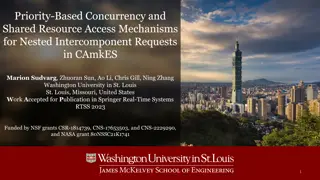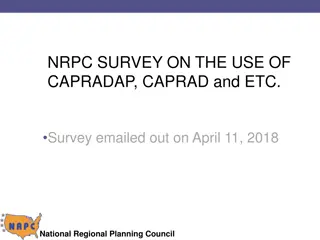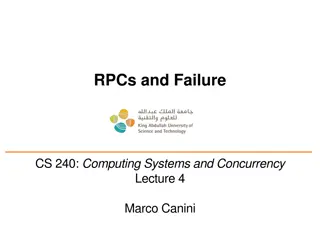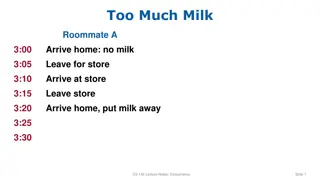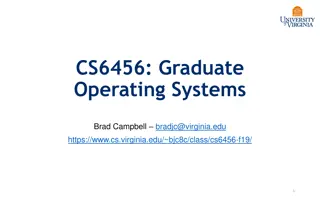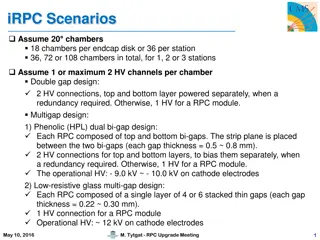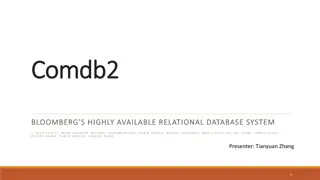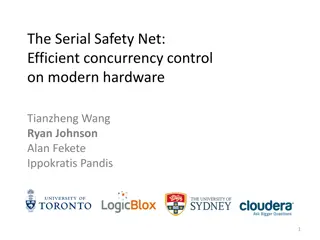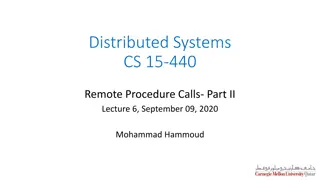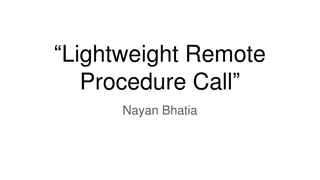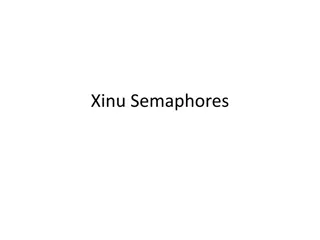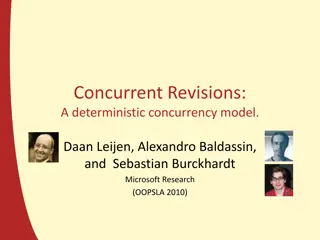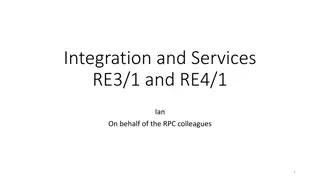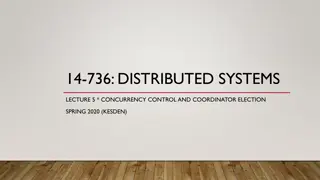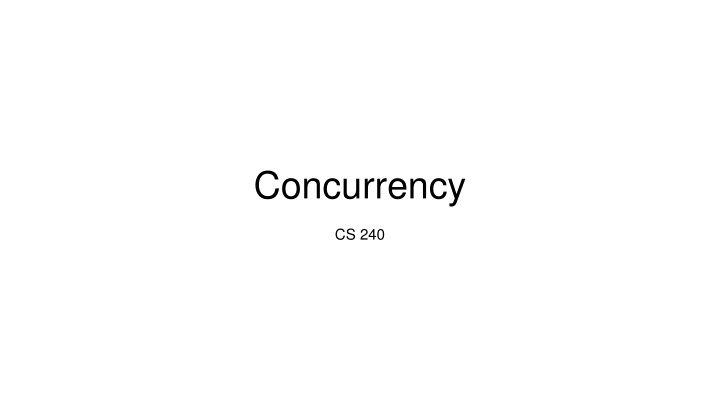
Concurrency and Parallelism in Computer Science
Explore the concepts of concurrency and parallelism in computer science through visual explanations and examples. Learn how they differ, their significance in distributed systems, and why concurrency matters even when not always parallel.
Download Presentation

Please find below an Image/Link to download the presentation.
The content on the website is provided AS IS for your information and personal use only. It may not be sold, licensed, or shared on other websites without obtaining consent from the author. If you encounter any issues during the download, it is possible that the publisher has removed the file from their server.
You are allowed to download the files provided on this website for personal or commercial use, subject to the condition that they are used lawfully. All files are the property of their respective owners.
The content on the website is provided AS IS for your information and personal use only. It may not be sold, licensed, or shared on other websites without obtaining consent from the author.
E N D
Presentation Transcript
Concurrency CS 240
What is Concurrency? It s like parallel that s not in parallel
What is Parallelism? Time Sequential f(X) = A f(X) f(Y) f(Y) = B Parallel f(X) f(X) = A f(Y) f(Y) = B
What is Concurrency? Time Sequential f(X) = A f(X) f(Y) f(Y) = B Concurrent f(X) = A f(X) f(Y) f(Y) = B
Concurrency Could be Parallel but not Always Time Concurrent but not Parallel f(X) = A f(X) f(Y) f(Y) = B Concurrent and Parallel f(X) = A f(X) f(Y) f(Y) = B f(Z) = A f(Z) f(W) f(W) = B
Parallel is Always Concurrent Time Parallel but not Concurrent? f(X) f(X) = A f(Y) f(Y) = B Nope still concurrent Parallel Concurrent Concurrent Parallel
Why Care about Concurrency If something concurrent but not parallel takes as much time as something sequential, why make it concurrent? Time f(X) = A Sequential f(X) f(Y) f(Y) = B Concurrent f(X) = A f(X) f(Y) f(Y) = B
Concurrency is a Design Pattern Concurrency is about dealing with lots of things at once. Parallelism is about doing lots of things at once. - Rob Pike Concurrency is not Parallelism by Rob Pike : https://talks.golang.org/2012/waza.slide#1
Distributed Systems are Unpredictable Servers need to react to: Others servers Crashes Users
Making Bank Deposits Concurrent (1/5) Add($10 ) Server Database Add($10 ) 0 Time
Making Bank Deposits Concurrent (2/5) Add($10 ) Server Database Add($10 ) read Read x = 0 $0 0 Time
Making Bank Deposits Concurrent (3/5) Add($10 ) Server Database Add($10 ) read Read x = 0 x += 10 Write x $0 $10 10 Time
Making Bank Deposits Concurrent (4/5) Add($10 ) Server Database Add($10 ) read Read x = 0 x += 10 Write x $0 $10 10 read Read x = 10 $10 Time
Making Bank Deposits Concurrent (5/5) Add($10 ) Server Database Add($10 ) read Read x = 0 x += 10 Write x $0 $10 20 read Read x = 10 x += 10 Write x $10 $20 Time
Concurrent Bank Deposits! Yay? (1/5) Add($10 ) Server Database Add($10 ) 0 Time
Concurrent Bank Deposits! Yay? (2/5) Add($10 ) Server Database Add($10 ) read Read x = 0 $0 0 Time
Concurrent Bank Deposits! Yay? (3/5) Add($10 ) Server Database Add($10 ) read Read x = 0 Read x = 0 $0 read $0 0 Time
Concurrent Bank Deposits! Yay? (4/5) Add($10 ) Server Database Add($10 ) read Read x = 0 Read x = 0 x += 10 Write x $0 read $0 10 $10 Time
Concurrent Bank Deposits! Yay? (5/5) Add($10 ) Server Database Add($10 ) read Read x = 0 Read x = 0 x += 10 Write x x += 10 Write x $0 read $0 10 $10 $10 Time
Concurrency Needs to be Synchronized Locks limit access using shared memory Channels pass information using a queue
Visualize Everything Weve Learned And also see many different methods of achieving synchronization: http://divan.github.io/posts/go_concurrency_visualize/
RPCs in Go RPCs in Go Networked battleship game CS 240
What is a RPC (Remote Procedure Call)? RPC means a client will execute some function on a remote server Client make a local requests with some parameters RPC library encodes the request and parameters, send them to server Server decodes the request and parameters Procedure is executed on the server Server sends back the reply to the client
RPC exercise We will use the net/rpc package to implement a client and server https://golang.org/pkg/net/rpc/ Server side: Create the server instance Define the procedure Listen for incoming requests Client side: Create the client instance and connect to the server Make the RPC
Battleship A grid map on which you place your ships Deploy attack on (N, 19)! Goal: Find and sink all enemy ships
Todays task: Implement a Battleship client Project files available on the Campuswire We will run a central server Implement the client (client.go) and test it against other students
Task 1 and 2 Establish connection to the server See https://golang.org/pkg/net/rpc/ example rpc.DialHTTP Must return a rpc.Client object Make the JoinGame request You want to call the remote BattleshipsService.JoinGame function Parameters PublicPlayer and JoinGameRequest are defined in common.go See https://golang.org/pkg/net/rpc/ example client.Call
Task 3 Implement the attack server Tasks 1 and 2 were making requests as a client, now must accept requests See https://golang.org/pkg/net/rpc/ Examples rpc.Register and rpc.HandleHTTP Create a listener to serve requests on a separate goroutine
Task 4 Implement the turn logic Hint: The turn logic can be achieved with Channels, Locks or WaitGroups Hint 2: When the other player attacks, you get a token to make one attack After implementation is complete, you can run against other players

